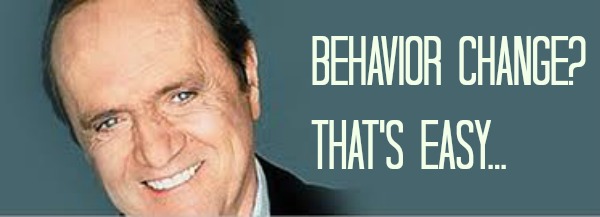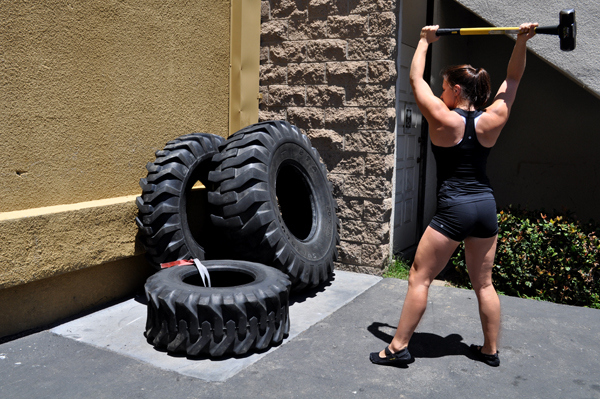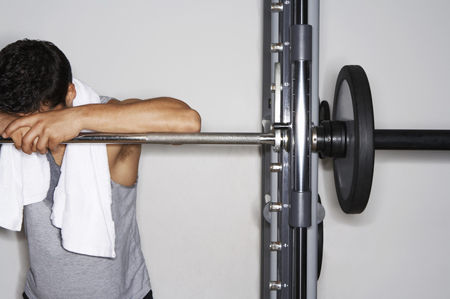Annoying Exercise Myths
If you’re still subscribing to any of these fitness/exercise myths, JUST STOP IT, as the old Bob Newhart psychiatrist character used to say (see here).
I’m keeping this list of pernicious myths short (just four), though like George Bush bloopers, there are so many to choose from. Like “spot-losing”….Please at least join the 20th century if you still believe you can “target” lose your belly fat. Or “lifting weights will make you bulky”. Every women’s health magazine has a diatribe against that one. So why are my four myths so annoying???
- Because they persist. Despite solid data which contradicts them, they might not even be “mostly dead”.
- They’re blocking you from optimal wellness. If they’re not injuring you, they’re at least slowing you down or making your exercise efforts less efficient.
- They’re indulged and even promoted by folks who should know better. No health professional is off the hook for at least trying to stay current.
Myth #1: The Fat-Burning Zone
This one says that at roughly 50% to 65% of your maximum heart rate (MHR),
you will burn more fat than at lower or higher exercise intensities. It’s built into the display of most cardio machines. This horrid idea is SUPER attractive.  Who doesn’t want to get rid of more fat with less work? 60% MHR burns more fat than 75%, right?
Who doesn’t want to get rid of more fat with less work? 60% MHR burns more fat than 75%, right?
Unfortunately, like late 70’s rock band attire, there are SO many things wrong here….
First, the basics. When you exercise, you draw energy from two primary resources: fat stores and glycogen stores. Glycogen (carbohydrate) is found in muscles and liver. You burn both when you exercise, but at lower fat-burning zone intensities , your body burns a higher proportion of fat than glycogen.
The first problem is the focus on relative vs total fat loss. Let’s say you burn 200 calories in a 40 minute fat-burning workout, 120 of which come from fat, 80 from glycogen. That’s 60% fat burn. In a higher intensity 40 minute workout, you torch 360 calories, 180 of which come from fat (that’s 50%). 180 fat calories is still more than 120, though the percentage of fat burned is lower with the higher intensity workout (50% as opposed to 60%). There is NO scenario where you burn more total fat from a lower intensity workout. Unless you follow your high intensity workout with two Boston creme doughnuts or a half-pint of Ben & Jerry’s Chunky Monkey. Or both. Yes, it is possible, and no, I’ve never done it.
Unfortunately all of the above is almost moot due to two after-workout effects that will not go away no matter how fervently treadmill and elliptical UI designers wish.
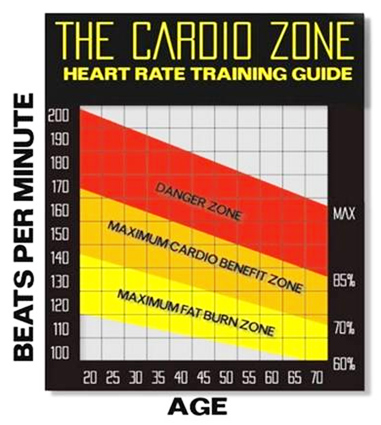 First, a low intensity workout does not increase your basal metabolic rate post-workout, while a high-intensity workout does. Meaning you’ll burn post-exercise calories at rest with a high-intensity workout that you will NOT lose with a fat-burning workout. This has been labeled “after-burn”. For the exercise geeks among you, see a summary here.
First, a low intensity workout does not increase your basal metabolic rate post-workout, while a high-intensity workout does. Meaning you’ll burn post-exercise calories at rest with a high-intensity workout that you will NOT lose with a fat-burning workout. This has been labeled “after-burn”. For the exercise geeks among you, see a summary here.
Related to after-burn; any activity that wakes up your body and forces muscle-growth adaptation will generally increase your resting metabolism. Fat-burning zone workouts on a treadmill don’t force adaptation, at least over time. Strength-training or a high intensity workouts (done right) can. A Corvette burns more fuel than a Prius because the engine is bigger. More muscle, bigger engine. Apologies to my Prius.
The second post-workout effect really puts this fat-burning zone idea into the ground. As Alex Hutchinson explains in his book “Which Comes First, Cardio or Weights?”, your body is highly adaptive and will replenish the store — either fat or carbohydrate — which was most seriously depleted during the workout (demonstrated by an Australian study in 2010, see here). More fat burn, more fat replacement. More glycogen burn, more glycogen replacement. Another important ramification of this is that fat-burning pills are not worth the plastic pill bottle they come in.
Bottom line? There’s absolutely a place for lower intensity exercise (see below). Any movement is great and better than the couch and a bag of chips. But if you’re trying to lose fat, don’t rely on the fat-burning zone. Build your fat-burning engine and eat better and fewer calories.
Myth #2: More exercise is better (and the corollary, no pain, no gain)
This might be the number one mistake set for the highly motivated. And for some Crossfitters who regard the dumbell rack as an all-you-can-lift buffet, who look confused if you say the word “over-training” and who say romantic things like, “My love for you is deeper than these squats, but seriously, watch me bust out these squats.”
Two big mistakes in this category. The first problem is more widespread and deserves more attention:
- Thinking that more is better, and ignoring sufficient recovery time and practices after exercise sessions.
- Exercising through pain. This is just dumb, and I say that with gentle compassion. Mild discomfort is expected and normal during and after workouts. But if you’re injured and have any sort of sharp or acute pain, stop and see a doctor. Here is quick summary of what appropriate “burn” should feel like and a longer guide to “good” vs. “bad” pain.
Anyone can succumb to these. I do, for lots of bad reasons, including the fun/exhilaration of some physical activities, mild denial (that “50 is the new 20!!!” voice) and deep personal psychological issues which are fascinating but unfit for publication. I’m kidding about the last one. In any case, I always regret over-training because it sets me back. If you’re like me, just stop it and read on.
More is simply not better. Working out actually creates micro-tears in muscle tissue. It’s the rebuilding adaptation of that “damaged” tissue that makes you stronger. With over-training and insufficient time to recover/rebuild, you get injuries, insomnia, tendinitis, mental fog, emotional instability (mood swings), weight and strength fluctuations, increased overall body inflammation, reduced endurance and poor concentration. Sound good? It’s the opposite of what you’re ostensibly trying to achieve with exercise: higher quality and prolonged life. Interestingly, not exercising enough can produce these same conditions. To summarize and state it positively, you actually get stronger faster if you don’t overdo it and take adequate time to recover.
Although workout frequency and recovery are governed by many factors (age, workout intensity, your training history, etc), here are some simple rules for workout frequency/intensity and recovery:
- Put at least 48 hours in between your strength workouts for the same muscle groups. If you’re doing a split-body workout (upper-body and lower-body in a separate sessions), you can get away with only 24 hours between sessions hitting different muscle groups.
- If you’re older (40 and up), you might need more recovery time. Up to 96 hours between sessions won’t hurt you, but you probably won’t need that much. Some protocols call for weekly strength workouts. And if it slows down your progress a bit, that’s a good tradeoff for avoiding injury.
- If you experience DOMS (Delayed Onset Muscle Soreness), wait until the severe soreness subsides to resume exercising. DOMS is muscle soreness that usually sets in 12-24 hours after exercise and is gone from 72 hours to a week. See a doctor if your DOMS lasts for more than a week. DOMS is fascinating and deserves its own post.
- You’re not ready to resume exercise if your muscles are still tender to a light touch. Or if you’re just completely fatigued. If you start your workout and you can’t lift or complete as much as the previous workout, you’re not ready for it. Stop and wait.

- Unless you’re injured, don’t take NSAIDs (Ibuprofen, for example) for muscle soreness. Recent studies show that they can interfere with muscle recovery and actually prolong it.
- After an endurance event, you might need longer than a week for recovery. Several studies point to neuromuscular junction fatigue — which can affect performance — after the muscles themselves have fully healed.
- You don’t need to become a couch potato during recovery periods. Doing nothing can work against recovery just as over-training can. Light activity during recovery periods — walking, cycling, mild yoga, dynamic stretching — will actually speed the recovery process.
- Get 7 to 8 hours of sleep daily and eat right. Sleep and post-exercise nutrition are good topics for another post (I won’t get detailed here), but are the most critical factors for efficient a magic recovery. Don’t skimp on protein, healthy fats or complex carbohydrates to recover well.
- You’re probably not an olympic or professional athlete; don’t train like one. The idea with exercise is to make consistent progress, have fun and improve the quality of your mental/physical existence. Be mindful about your goals and how your exercise activity connects/relates to those goals. If you’re competing, great, but what’s the over-arching goal? Most pro athletes don’t have a prolonged life span; they torture their bodies and create imbalance in one way or another to optimize their performance in one special area. No need to imitate ’em.
- Be mindful in general and pay attention to your body.
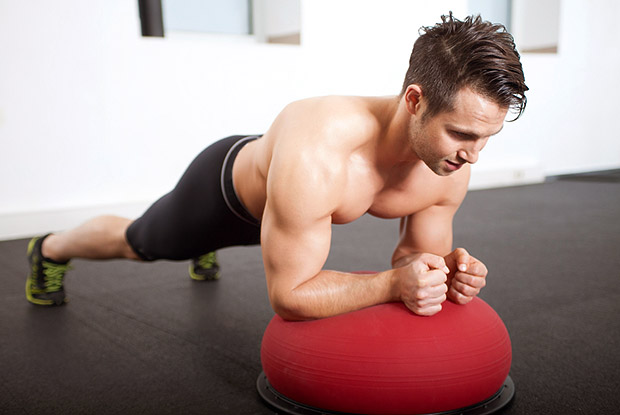 Experiment and discover what works and what doesn’t work in terms of intensity and recovery. Listening to your body is a lost art for some, but it’s not hard to rediscover. Logging your workouts and taking time to note general sensations after a workout can help.
Experiment and discover what works and what doesn’t work in terms of intensity and recovery. Listening to your body is a lost art for some, but it’s not hard to rediscover. Logging your workouts and taking time to note general sensations after a workout can help.
Myth #3: A Low Intensity Workout is a Waste of Time
This idea is the bad corollary to a great idea: high intensity workouts, or High Intensity Interval Training (HIIT). As HIIT has gained popularity (for good reasons), so has the inverse oversimplification that a low intensity won’t do you any good. 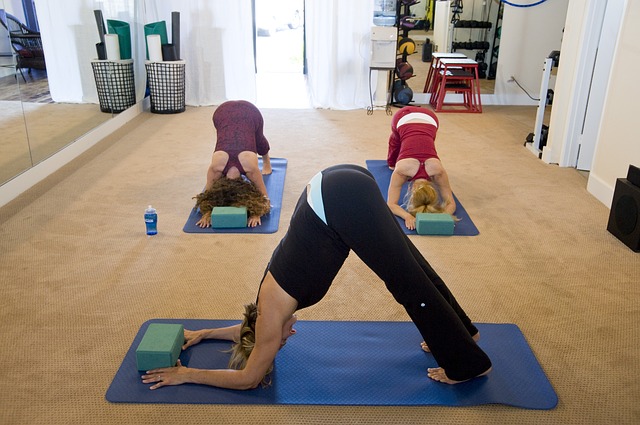 Walking and yoga, says this myth (for example), are close to useless. Variations or other wrong corollaries to this idea include: “a hard daily workout gives me a pass on other daily activity or inactivity”, “you’ve got to exercise hard for 45 minutes daily to see any benefit”, and “you’ll only get stronger if you lift heavy weights”. We’ll touch on these three as well.
Walking and yoga, says this myth (for example), are close to useless. Variations or other wrong corollaries to this idea include: “a hard daily workout gives me a pass on other daily activity or inactivity”, “you’ve got to exercise hard for 45 minutes daily to see any benefit”, and “you’ll only get stronger if you lift heavy weights”. We’ll touch on these three as well.
Problems with this myth:
- High intensity training is good for you. But not every day (see myth #2). On off or recovery days, lighter or lower intensity activity like walking or yoga is just what the doctor ordered.
- While lower intensity activity might not force muscle growth adaptations, it can prevent maladaptation. Huh??? Okay, here it is. Sitting at your desk for extended periods is really bad for you. And it’s a frightening and relatively new revelation that even intense daily exercise will not offset the negative effects of sedentary behavior. The antidote?? Lower intensity movement during the day. Even a few minutes every half an hour can keep your skeletal muscles turned on and reduce the risk of disease. Standing desks are also a great idea.
- Lower intensity activity can be meditative and good for the brain. And what’s good for the brain is good for the body. While high intensity training is great, it also typically induces stress. Walking and other mild forms of exercise can eliminate stress. It’s a great accompaniment, therefore, to hard workouts.

- Lower intensity activity can be social. Not that some forms of high intensity training can’t, but let’s face it; when you’re wheezing to repay an oxygen debt, it’s not the optimal time for a chat.
- Lower intensity activity can target flexibility. While strength training and flexibility are not adversaries (that’s another myth and false dichotomy), a high intensity training session generally doesn’t target flexibility. Yoga or Pilates or dynamic stretching or other lower intensity activities can. Again, a good complement to strength training or HIIT.
- A regular morning walk is a great way to start the day. No big science here, just my personal opinion. And first thing in the morning is NOT the optimal time for HIIT.
Finally, to briefly take on the sub-myth that only lifting heavy weights — as opposed to lighter weights with more repetitions — will make you stronger…. This subject is complex, but I’ll keep it simple. What matters most is not how much you lift, but lifting to fatigue (until you can’t lift anymore with good form), as a 2010 study from McMasters University demonstrated. Lifting 25 pounds twenty times can be practically as effective as lifting 35 pounds ten times, as long as you go to fatigue. There are virtues in lifting heavy weights (neuromuscular junction response/development, targeting fast twitch muscle, etc.) And lifting heavier weights with fewer reps takes less time; better for the time-crunched. One disadvantage of lifting heavier is that it’s less forgiving if you’re not attentive to form; you’ll be more vulnerable to injury. More on this issue in a future blog post!
Myth #4: Stretching Before a Workout Prevents Injury and Decreases Muscle Soreness
Pre-exercise stretching turns out not only to be unnecessary but actually counter-productive. Most athletic trainers/coaches now embrace this, and encourage stretching as a post-exercise activity. But we still equate stretching with warming up. Just stop it.
Last year The Journal of Strength and Conditioning Research that stretching as strength-training precursor led to wobbly lifts and weaker performance.
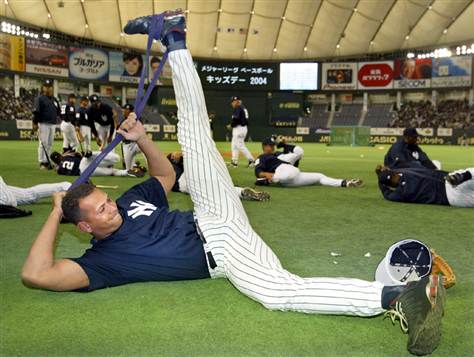 Other studies from Scandinavia and elsewhere confirm that performance is compromised and the likelihood of injuries increases with static stretching before workouts. “Static” stretching just means elongating your muscles in a single position and then holding it without movement. , on the other hand, involves continuous movement. The picture to the left illustrates a static stretch.
Other studies from Scandinavia and elsewhere confirm that performance is compromised and the likelihood of injuries increases with static stretching before workouts. “Static” stretching just means elongating your muscles in a single position and then holding it without movement. , on the other hand, involves continuous movement. The picture to the left illustrates a static stretch.
What is the best way to warm up then? Warming up is NOT optional, particularly for the “new 20” year olds like me. When you begin a work out from a sitting start, less than 50% of your blood supply is available to your skeletal muscles. Warming up actually does just that. It heats up skeletal muscle tissue and opens capillaries to make blood (and therefore oxygen) available to your muscles. If you don’t want to perform better and avoid injury, don’t warm up. Here are some (very) quick tips:
- Dynamic stretching is the short answer. This five minute routine works very well.
- Do a less intense version of your exercise for the first 5 to 10 minutes. For example, if you’re going to cycle, go at half pace in the beginning. If you’re going to lift weights, do a quick circuit where you lift half (or less than half) or your intended load.
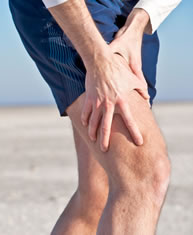 Finally, how about the idea that static stretching might decrease post-exercise muscle soreness or DOMS? It’s well-known and non-controversial that static stretching does NOT work. Other things that don’t work? Heat, fish oil, and ice. Ice is controversial, but I can’t recommend it. Unfortunately, the science on what does work is murky at best, largely because the causes of DOMS are not well understood. Here are some tips that work for some folks to mitigate post-exercise muscle soreness and regret:
Finally, how about the idea that static stretching might decrease post-exercise muscle soreness or DOMS? It’s well-known and non-controversial that static stretching does NOT work. Other things that don’t work? Heat, fish oil, and ice. Ice is controversial, but I can’t recommend it. Unfortunately, the science on what does work is murky at best, largely because the causes of DOMS are not well understood. Here are some tips that work for some folks to mitigate post-exercise muscle soreness and regret:
- Dynamic stretching before exercise seems to help some people.
- A very mild workout on the day after your intense or DOMS inducing workout.
- Massage might help, particularly from a sports massage therapist. Foam rolling within 2 hours after your workout isn’t nearly as much fun, but can also work.
- Caffeine after the training day has been shown to attenuate soreness.
- Eating and sleeping and drinking enough. Your muscles need fuel to rebuild.
- For the geeky among your, consumption of BCAA’s (Branch Chain Amino Acids; these are particular proteins) might help. Geeks, please see more data here.
Those are my four myths. If you’re subscribing, you can end your subscription to these busted ideas. And you don’t even have to see a hostile psycho-therapist to do so.
![]()

